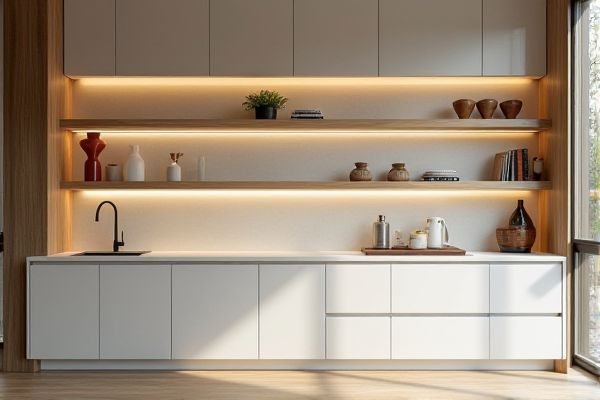
Cabinet doors provide a sleek, organized look while protecting your items from dust and clutter, whereas open shelving offers easy access and a modern, airy feel that showcases your decor. Explore the rest of the article to find out which storage option best suits your space and lifestyle.
Table of Comparison
| Feature | Cabinet Doors | Open Shelving |
|---|---|---|
| Storage Protection | Protects items from dust and dirt | Exposes items; prone to dust accumulation |
| Visual Appeal | Creates clean, concealed look | Offers decorative display opportunities |
| Accessibility | Requires opening doors; less immediate access | Easy and quick access to items |
| Maintenance | Lower cleaning frequency needed | Requires frequent dusting and organization |
| Cost | Generally more expensive due to materials and hardware | Typically more affordable and customizable |
| Space Utilization | Maximizes hidden storage space | Limits storage; items must be neatly arranged |
| Customization | Limited to door design and finish options | Flexible layout for diverse display styles |
Introduction to Cabinet Doors and Open Shelving
Cabinet doors provide a clean, organized look by concealing storage spaces, offering protection from dust and maintaining a streamlined kitchen aesthetic. Open shelving displays items openly, enhancing accessibility and creating a sense of spaciousness while allowing homeowners to showcase decorative dishware or frequently used utensils. Choosing between cabinet doors and open shelving depends on preferences for privacy, maintenance, and visual style in kitchen design.
Aesthetic Differences: Classic vs. Contemporary
Cabinet doors offer a classic, polished look that conceals clutter and provides a cohesive, traditional aesthetic ideal for timeless kitchen designs. Open shelving creates a contemporary, airy atmosphere, showcasing dishware and decorative items as part of the room's visual appeal. Your choice depends on whether you prefer the clean, structured elegance of cabinet doors or the modern, accessible vibe of open shelving.
Storage Capacity and Organization
Cabinet doors provide ample storage capacity by concealing items, helping maintain a clutter-free environment while protecting belongings from dust and damage. Open shelving offers easy access and display options but typically requires frequent organization to prevent a messy appearance. Choosing between the two depends on your need for hidden storage versus visible, readily accessible organization.
Accessibility and Convenience
Cabinet doors provide a clean, organized look while protecting contents from dust and damage, making them ideal for storing less frequently used items. Open shelving offers immediate accessibility and convenience, allowing you to quickly grab everyday essentials and display attractive dishware. Your choice depends on whether you prioritize ease of access or protection and a tidy appearance in your kitchen.
Maintenance and Cleaning Requirements
Cabinet doors offer better protection against dust, grease, and spills, reducing the frequency and intensity of cleaning compared to open shelving. Open shelves require regular dusting and wiping since all items are exposed to airborne particles and kitchen residues. Choosing cabinet doors can save you time and effort in maintenance, especially in busy or high-traffic areas.
Impact on Kitchen Space and Layout
Cabinet doors maximize kitchen space by providing concealed storage that keeps countertops clutter-free and maintains a streamlined layout, ideal for smaller kitchens or those needing a tidy appearance. Open shelving creates an airy, spacious feel by visually expanding the kitchen and offering easy access to frequently used items, making it perfect for showcasing dishware and enhancing the room's design. Your choice between cabinet doors and open shelving will significantly influence both the functionality and aesthetic flow of your kitchen space.
Cost Comparison: Budget Considerations
Cabinet doors typically cost more upfront due to materials and installation labor, while open shelving offers a budget-friendly alternative with lower material and labor expenses. Open shelving reduces the need for hinges, hardware, and detailed craftsmanship, making it ideal for cost-conscious renovations. However, factoring in long-term maintenance and potential need for decorative organization can influence the overall budget comparison.
Personalization and Display Options
Cabinet doors offer a customizable look with various materials, finishes, and hardware choices that allow you to tailor your kitchen style while keeping items hidden for a clean appearance. Open shelving provides a versatile display option, enabling you to showcase decorative dishes, glassware, and collectibles, enhancing the room's aesthetic with personalized arrangements. Your choice between these storage solutions impacts both the visual appeal and functionality of your kitchen space.
Durability and Longevity
Cabinet doors provide superior protection against dust, moisture, and physical damage, enhancing durability and extending the lifespan of stored items compared to open shelving. High-quality materials like solid wood or metal used in cabinet doors resist wear and tear, ensuring long-term structural integrity. In contrast, open shelving exposes items to environmental factors, potentially reducing the longevity of both the shelving and the stored belongings.
Which Option Is Right for Your Kitchen?
Cabinet doors provide a sleek, organized look and protect dishes from dust and grease, making them ideal for kitchens with limited cleaning time or a preference for a minimalist style. Open shelving offers easy access and displays decorative items, perfect for smaller kitchens or those aiming for an airy, modern aesthetic. Evaluating your storage needs, maintenance preferences, and design goals will help determine whether cabinet doors or open shelving suits your kitchen best.
 homyna.com
homyna.com